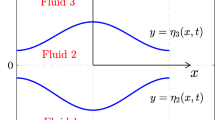Abstract
To describe the evolution of an interface between two immiscible media, an equation for a volume fraction function is derived, with the interface curvature effect being described by a “continuum model” of a surface tension force. A numerical study of the Rayleigh-Taylor instability problem is performed for different density ratios ρ 1/ρ 2 on the interface, including the real cases corresponding to available experimental data. At the initial stage, the instability development is independent of ρ 1/ρ 2 and consistent with the Taylor linear theory, then (for ρ 1/ρ 2 < 5) a spiral-like Kelvin-Helmholtz instability structure is observed. For ρ 1/ρ 2 < 2, the instability development pattern remains symmetric until large times when (same as for large ρ 1/ρ 2) an asymmetry appears. The surface tension and the viscosity result in the suppression of the Rayleigh-Taylor instability disturbances and secondary small-scale irregularities of the interface.
Similar content being viewed by others
References
W.H. Cabot and A.W. Cook, “Reynolds Number Effects on Rayleigh-Taylor Instability with Possible Implications for Type-Ia Supernovae,” Nature Phys. 2, 562–568 (2006).
N.J. Hammer, H.-Th. Janka, and E. Müller, “Three-Dimensional Simulations of Mixing Instabilities in Supernova Explosions,” Astrophys. J. 714, 1371–1385 (2010).
S.I. Abarzhi, “Review of Theoretical Modelling Approaches of Rayleigh-Taylor Instabilities and Turbulent Mixing,” Phil. Trans. R. Soc. A. 368, 1809–1828 (2010).
G. Dimonte, D.L. Youngs, A. Dimits, et al., “A Comparative Study of the Turbulent Rayleigh-Taylor Instability Using High-Resolution Three-Dimensional Numerical Simulations: The Alpha-Group Collaboration,” Phys. Fluids 16, 1668–1693 (2004).
S.I. Voropaev, Y.D. Afanasyev, and G.J.F. van Heijst, “Experiments on the Evolution of Gravitational Instability on an Overturned, Initially Stably Stratified Fluid,” Phys. Fluids A. 5, 2461–2466 (1993).
S.N. Yakovenko, T.G. Thomas, and I.P. Castro, “A Turbulent Patch Arising from a Breaking Internal Wave,” J. Fluid Mech. 677, 103–133 (2011).
C.W. Hirt and B.D. Nichols, “Volume of Fluid (VOF) Method for the Dynamics of Free Boundaries,” J. Comput. Phys. 39, 201–225 (1981).
M. Rudman, “Volume-Tracking Method for Interfacial Flow Calculations,” Int. J. Numer. Meth. Fluids 24, 671–691 (1997).
F.J. Kelecy and R.H. Pletcher, “The Development of a Free Surface Capturing Approach for Multidimensional Free Surface Flows in Closed Containers,” J. Comput. Phys. 138, 939–980 (1997).
J.U. Brackbill, D.B. Kothe, and C. Zemach, “A Continuum Method for Modeling Surface Tension,” J. Comput. Phys. 100, 335–354 (1992).
S.N. Yakovenko and K.S. Chan, “Application of a Continuum Model for the Surface Tension Force to the Rayleigh-Taylor Instability Problem,” Thermophysics and Aeromechanics 18(3), 449–461 (2011).
S.N. Yakovenko and K.S. Chan, “Application of Volume-Fraction Fluxes in a Two-Fluid Flow,” Thermophysics and Aeromechanics 15(2), 449–461 (2008).
G.I. Taylor, “The Instability of Liquid Surfaces When Accelerated in a Direction Perpendicular to Their Planes. I,” Proc. R. Soc. Lond. A. 201, 192–196 (1950).
D.J. Lewis, “The Instability of Liquid Surfaces When Accelerated in a Direction Perpendicular to Their Planes. II,” Proc. R. Soc. Lond. A. 202, 81–96 (1950).
D.I. Pullin, “Numerical Studies of Surface-Tension Effects in Nonlinear Kelvin-Helmholtz and Rayleigh-Taylor Instability,” J. Fluid Mech. 119, 507–532 (1982).
B.J. Daly, “Numerical Study of Two-Fluid Rayleigh-Taylor Instability,” Phys. Fluids 10, 297–307 (1967).
D.L. Youngs, “Numerical Simulation of Turbulent Mixing by Rayleigh-Taylor Instability,” Physica D 12, 32–44 (1984).
G. Tryggvason, “Numerical Simulations of the Rayleigh-Taylor Instability,” J. Comput. Phys. 75, 253–282 (1988).
D.L. Youngs, “Modelling Turbulent Mixing by Rayleigh-Taylor Instability,” Physica D 37, 270–287 (1989).
G.R. Baker, D.I. Meiron, and S.A. Orszag, “Vortex Simulations of the Rayleigh-Taylor Instability,” Phys. Fluids 23, 1485–1490 (1980).
B.J. Daly, “Numerical Study of the Effect of Surface Tension on Interface Instability,” Phys. Fluids 12, 1340–1354 (1969).
H.W. Emmons, C.T. Chang, and B.C. Watson, “Taylor Instability of Finite Surface Waves,” J. Fluid Mech. 7, 177–193 (1960).
F.H. Harlow and J.E. Welch, “Numerical Study of Large-Amplitude Free-Surface Motions,” Phys. Fluids 9, 842–851 (1966).
Author information
Authors and Affiliations
Corresponding author
Additional information
Original Russian Text © S.N. Yakovenko, 2014, published in Izvestiya Rossiiskoi Akademii Nauk, Mekhanika Zhidkosti i Gaza, 2014, Vol. 49, No. 6, pp. 54–69.
Rights and permissions
About this article
Cite this article
Yakovenko, S.N. The effects of density difference and surface tension on the development of Rayleigh-Taylor instability of an interface between fluid media. Fluid Dyn 49, 748–760 (2014). https://doi.org/10.1134/S0015462814060064
Received:
Published:
Issue Date:
DOI: https://doi.org/10.1134/S0015462814060064



